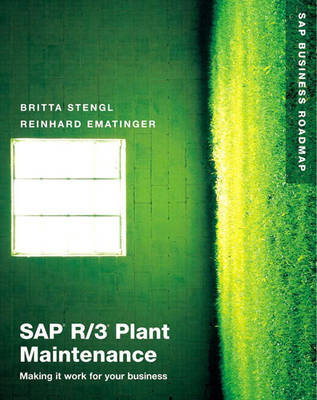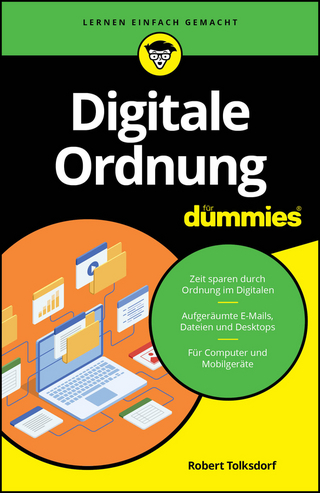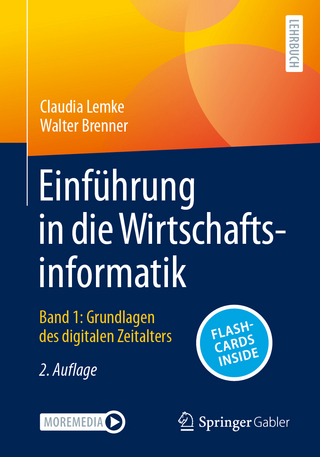
SAP R/3 Plant Maintenance
Addison-Wesley Professional (Verlag)
978-0-201-67532-0 (ISBN)
- Titel ist leider vergriffen;
keine Neuauflage - Artikel merken
SAP R/3 Plant Maintenance offers a clear introduction to this small but sophisticated component and provides a highly practical guide to implementing PM. Beginning with a examination of the key business processes underlying PM functionality, the book goes on to cover all the crucial aspects of maintenance planning and execution in R/3. Particular attention is given to integrating plant maintenance with a company's natural process flow.
Britta Stengl is a certified Plant Maintenance (PM) and Customer Service (CS) consultant of many years' experience. She works for SAP AG at its headquarters in Walldorf, Germany. Reinhard Ematinger is a certified Plant Maintenance (PM) and Customer Service (CS) consultant of many years' experience. He works for SAP AG at its headquarters in Walldorf, Germany. 0201675323AB07032001
Contents
Preface I
Preface II
Preface III
INTRODUCTION
1.1 Business Processes and Roles
1.2 Structure of this Book
1.3 Target Groups
1.4 Working with this Book
CLASSIFYING PLANT MAINTENANCE FROM A
BUSINESS PERSPECTIVE
2.1 Definitions
2.1.1 Plant maintenance to DIN 31051
2.1.2 System-oriented plant maintenance
2.1.3 Extended plant maintenance
2.1.4 Malfunction and breakdown
2.2 Traditional Forms of Organization in Plant Maintenance
2.2.1 Plant maintenance in line organization
2.2.2 Plant maintenance in the line-staff organization structure
2.2.3 Plant maintenance in matrix organization
2.2.4 Classification of external plant maintenance
2.3 Planning in Plant Maintenance
2.3.1 Planning and control
2.3.2 Strategy plans and maintenance task lists
2.4 Plant Maintenance Methods
2.4.1 Damage-based plant maintenance
2.4.2 Time-based plant maintenance
2.4.3 Condition-based plant maintenance
2.5 Benchmarking in Plant Maintenance Based on Key
Performance Indicators
2.6 Modern Plant Maintenance Management
2.6.1 Total Productive Maintenance (TPM)
2.6.2 Reliability Centred Maintenance (RCM)
2.6.3 Life Cycle Costing
2.6.4 Decentralized Equipment and Process Responsibility
(DAPV)
2.6.5 Other trends
GETTING STARTED WITH RELEASE 4.6
3.1 The PM Menu with Easy Access
3.1.1 How to display the maintenance processing menu
after logging on to R/3
3.1.2 How to display a role-specific PM menu after logging on
3.1.3 How to add Internet pages and files to your menu
3.2 The Business Workplace
3.2.1 Working with the Business Workplace
3.3 Support Line Feedback as an Interface to SAP
3.3.1 How to create an R/3 notification
3.3.2 How your support team processes the R/3 notification
3.3.3 How to activate support line feedback
3.4 PM Documentation in the SAP Library
3.5 How to Call up PM Documentation in the SAP Library
3.5.1 How to call up release notes on PM
3.5.2 How to call up PM documentation in the implementation
guide (IMG)
3.5.3 How to call up PM terms in the glossary
OBJECTS IN R/3 PM
4.1 Managing Technical Objects
4.1.1 The concept of plants in the R/3 System
4.1.2 Maintenance plants and maintenance planning plants
4.1.3 How to define a plant as a maintenance planning plant
4.2 Functional Locations and Equipment
4.2.1 Functional locations
4.2.2 Equipment
4.3 The Most Important Transactions for Functional Locations and
Equipment
4.4 Using other Logistics Master Data in PM
4.4.1 Material
4.4.2 Assembly
4.4.3 Serial numbers
4.4.4 PM bill of material
4.4.5 The most important transactions for other Logistics master
data
4.5 Measuring Points and Counters
4.5.1 The most important transactions for measuring points and
counters
4.6 PM Work Centres
4.7 Maintenance Task Lists and Maintenance Plans
4.8 Maintenance Notifications
4.9 Maintenance Orders
BUSINESS PROCESS: BREAKDOWN MAINTENANCE AND CORRECTIVE MAINTENANCE
5.1 Tasks of the PM Technician
5.1.1 Basics of maintenance notifications
5.1.2 Activity reports
5.1.3 Malfunction reports
5.1.4 Maintenance requests
5.1.5 User-specific notifications
5.1.6 Completion confirmations
5.1.7 Displaying completion confirmations
5.2 Tasks of the PM Planner
5.2.1 Structure of the order
5.2.2 Notifications and orders
5.2.3 Monitoring outstanding notifications
5.2.4 Order types in PM
5.2.5 Work scheduling
5.2.6 Material planning in orders
5.2.7 Order release
5.2.8 Technical completion
5.2.9 Order status
5.3 Tasks of the Controller
5.3.1 Estimated costs, planned costs and actual costs
5.3.2 Order budget
5.3.3 Order settlement
5.3.4 Order analysis in CO
5.3.5 Cost evaluation in the Plant Maintenance Information System
BUSINESS PROCESS: PLANNED MAINTENANCE
6.1 Tasks of the PM Technician
6.2 Tasks of the PM Planner
6.2.1 Preventive versus continuous maintenance
6.2.2 Work scheduling
6.2.3 Maintenance planning
6.3 Tasks of the Controller
SPECIAL CASES
7.1 Refurbishment Processing
7.1.1 Inventory management and condition-based material
valuation
7.1.2 Standard price and moving average price
7.1.3 How the PM planner creates refurbishment orders
7.1.4 How PM technicians carry out refurbishment
7.1.5 How the PM planner technically completes orders
7.1.6 How the stock controller checks the cost flow in
refurbishment
7.2 External Services Management
7.2.1 Processes in external services management
7.2.2 How the PM planner uses control keys
7.2.3 How the PM planner uses external work centres
7.2.4 How the PM planner uses individual purchase orders
7.2.5 How the PM planner uses service specifications
7.2.6 How the controller checks external processing
INTEGRATIVE ASPECTS
8.1 Integration of the PM Component: General
8.2 Integration of the Materials Management (MM) Component
8.3 Integration of the Production Planning (PP) Component
8.4 Integration of the Quality Management (QM) Component
8.4.1 Process flow in test equipment management
8.5 Integration of the Project System (PS) Component
8.5.1 Basics of project planning
8.5.2 Planning structures and schedules
8.5.3 Processing plant maintenance projects
8.6 Integration of the Investment Management (IM) Component
8.6.1 Basics of Investment Management
8.6.2 Processing maintenance orders as investment measures
8.7 Integration of the Controlling (CO) Component
8.8 Integration of the Asset Accounting (FI-AA) Component
8.8.1 Equipment as an object in Asset Accounting
8.8.2 Workflow for data synchronization
8.9 Integration of the Human Resources (HR) Component
8.9.1 Time sheets: basics
8.9.2 CATS and Plant Maintenance
8.9.3 Prerequisites for using CATS
INTERFACES TO NON-SAP SYSTEMS
9.1 Interface to Process Control Systems and Building Control Systems
How process control systems and building control systems can contribute to plant maintenance
9.1.2 The PM-PCS interface
9.2 Interfaces to CAD Systems
9.2.1 How CAD systems can contribute to plant maintenance
APPENDIX A CUSTOMISING MIND MAPS
A.1 Reading and Creating Customizing Mind Maps
A.1.1 Mind Maps and MindManager
A.1.2 Customizing Mind Maps
A.1.3 Using Customizing Mind Maps to create overviews
A.1.4 Using Customizing Mind Maps in planning
A.2 Customizing Mind Maps for notification processing in PM
A.2.1How to create a Mind Map for notification processing
A.2.2How to create Mind Maps for the individual work packages in Customizing
APPENDIX B WORKSHOPS
B.1 Role-Based Workshop
B.1.1 The basic concept
B.1.2 Procedure and schedule
B.1.3 Tasks in phase one - short presentations and demos on plant maintenance
B.1.4 Tasks in phase two - group work on requirements and tasks
B.1.5 Tasks in phase three - role-based project work using the R/3 System
B.1.6 Final feedback session and planning a follow-up workshop
B.2 Integration workshop
B.2.1 The basic concept
B.2.2 Procedure and schedule
B.2.3 Tasks in phase one
B.2.4 Tasks in phase two
B.2.5 Background information on the model company FreezeMe Inc.
9.2.1 Data to be defined by the workshop participants
9.2.2 Business process prototypes for the presentation
| Erscheint lt. Verlag | 3.4.2001 |
|---|---|
| Sprache | englisch |
| Maße | 190 x 241 mm |
| Gewicht | 850 g |
| Themenwelt | Mathematik / Informatik ► Informatik ► Netzwerke |
| Informatik ► Office Programme ► Outlook | |
| Wirtschaft ► Betriebswirtschaft / Management ► Unternehmensführung / Management | |
| ISBN-10 | 0-201-67532-3 / 0201675323 |
| ISBN-13 | 978-0-201-67532-0 / 9780201675320 |
| Zustand | Neuware |
| Informationen gemäß Produktsicherheitsverordnung (GPSR) | |
| Haben Sie eine Frage zum Produkt? |
aus dem Bereich


